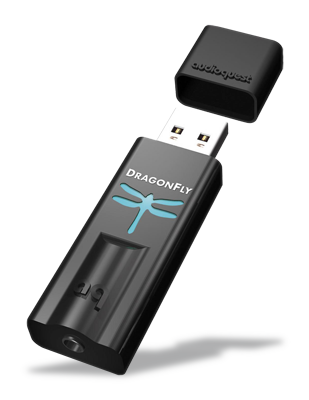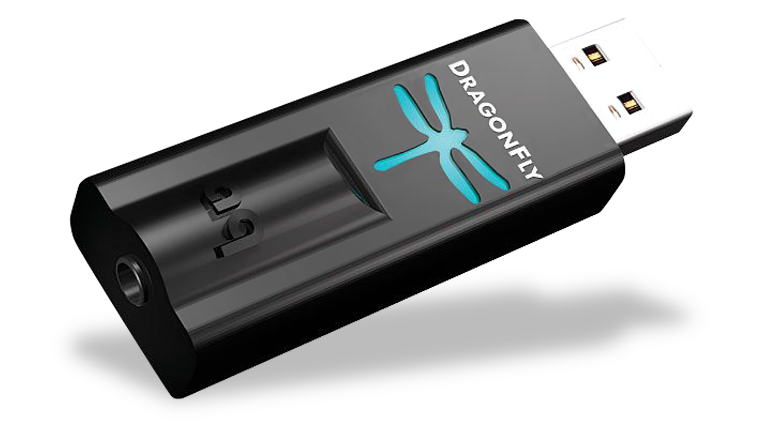
 What happens when a company known as a manufacturer of cables for professional and home audio, home theater, and custom installations decides to stick their toe in the audio-component-manufacturing pond? You want a USB DAC to use with earbuds or headphones? Check! You want a USB DAC to feed your stereo preamp or surround processor? Check! You want a built-in analog-domain volume control for direct connection to your power amplifier? Check! You want to connect it to a USB port without a cable? Check! You want it to be the size of a USB memory stick? Check! You want it to cost less than $250? Check! You want it to sound great? Check! You want the DragonFly logo to change colors when you play different sample rates? Check! You want it to be made in the USA? Check that, too!
What happens when a company known as a manufacturer of cables for professional and home audio, home theater, and custom installations decides to stick their toe in the audio-component-manufacturing pond? You want a USB DAC to use with earbuds or headphones? Check! You want a USB DAC to feed your stereo preamp or surround processor? Check! You want a built-in analog-domain volume control for direct connection to your power amplifier? Check! You want to connect it to a USB port without a cable? Check! You want it to be the size of a USB memory stick? Check! You want it to cost less than $250? Check! You want it to sound great? Check! You want the DragonFly logo to change colors when you play different sample rates? Check! You want it to be made in the USA? Check that, too!
Use
Using the AudioQuest DragonFly ($249 USD) with a Windows or Mac operating system is essentially plug-and-play. All you have to do is find the setting in your computer operating system and/or playback software that will direct the sound output to the DragonFly. Digital goes in via the directly connected USB plug. Analog stereo is output via the stereo mini-jack at the other end of the DragonFly, which will drive any load from 12 ohms up. Power comes from the USB port, so there are no batteries to recharge or wall-wart power supplies to connect. USB power isn’t as clean as you want for high-fidelity audio, so some of the 107 components mounted on the DragonFly’s tiny circuit board are there just to clean that up. That ensures a much better-sounding analog signal than you could otherwise expect. Small as the DragonFly is, it feels solid. The package includes a small fabric bag with a drawstring, and a protector that slips over the USB plug when the DragonFly isn’t connected to anything. No other connectors or cables are included.
A change in the signal’s sample rate causes the color of the DragonFly logo to change: 44.1kHz is green, 48 is blue, 88.2 is amber, and 96 is magenta. If you play a file with a sample rate of 176.4 or 192kHz, your playback software will know that the DragonFly maxes out at 96kHz, and the sample rate of the hi-rez files will be halved to 88.2 or 96kHz. Differences in bit depth aren’t indicated in any way, but the DragonFly does support 16- and 24-bit files. USB DACs still vary as to what sample rate they will accept. I’ve seen USB interfaces limited to sample rates no higher than 48kHz in products selling for $800 to $10,000. The DragonFly can handle sample rates that some far more expensive products can’t.
Using the DragonFly with earbuds or headphones should be very straightforward, as its stereo mini-jack is the de facto standard connector. Some ’phones still come with a large headphone plug. In some cases, that large plug can be unscrewed to reveal a stereo mini-jack. If you plan to connect the DragonFly to the line-level input of your stereo preamp, AVR, or surround processor, you’ll probably need an interconnect with a stereo mini-jack on the DragonFly end and RCAs or XLRs on the preamp/processor end. AudioQuest makes these in many different lengths (including custom lengths) and at many different prices. Prices for 2m AudioQuest cables range from $35 to $1395. For the review, AudioQuest provided 2m Yosemite analog interconnects ($795). That seemed like overkill for a $249 DAC, but I have to say, they made the DragonFly sound so good that I had to ask for an RCA-to-RCA pair of Yosemite to use with my reference DAC, a Wavelength Proton, so as not to overstate the DragonFly’s performance. I hated to turn the bargain-priced DragonFly into a $1000+ DAC by adding the Yosemite, but the difference this interconnect made with the Proton DAC was stunning. If the DragonFly were merely “good for the money,” the interconnects would have been a waste of money, but the DragonFly is a legitimate high-end product and the Yosemite was definitely not overkill. On the other hand, I doubt you need $795 interconnects to enjoy the DragonFly’s performance, though I had no “lesser” cables on hand to put that to the test.

The Wavelength Proton is designed and manufactured by Gordon Rankin, who also developed the Streamlength asynchronous USB data-transfer protocol. In fact, Rankin developed for AudioQuest all of the DragonFly’s internal circuitry, including its implementation of Streamlength.
My Toshiba laptop and Mac Mini computers only produce analog audio through their headphone jacks, resulting in poor sound in both cases: small, squeezed, airless, gritty, dull, and lifeless, with a high noise floor. The DragonFly was far superior to the headphone output of either. If you’re thinking about using a DragonFly to improve your listening experience through your computer, you probably won’t be disappointed. But beware: compressed MP3 and M4A music files, even at higher bit rates like 320kbps, don’t really sound that great. They don’t necessarily sound bad so much as they sound limited or hemmed-in compared to the original uncompressed files. Because most popular music of the last 15 years or so (pop, rap, hip-hop, alternative, rock, etc.) is decidedly lo-fi in the first place, those recordings tend to suffer a bit less when compressed than really well-recorded music. For my money, compression sucks the life out of well-recorded music. The DragonFly did a perfectly fine job with compressed files, especially compared to my computers’ headphone outputs. But to experience high-end sound quality with the DragonFly, you need to feed it uncompressed music, such as losslessly compressed file formats like FLAC or ALAC.
Sound
The DragonFly’s sound was clear and refreshing, like a tall gin-and-tonic on a warm summer afternoon, served in a clear tumbler and made with the perfectly clear ice you can’t get from your own freezer. The sound was pristine and pure, with great detail and surprisingly low background noise, considering that it draws its power from the USB port. The DragonFly was fully capable of revealing depth and width with better recordings. You might think such a low-power, ultracompact device would be a bit reticent in the bass, but it wasn’t; bass drive was robust, with great impact and power when appropriate, and just as strong and powerful as what I’ve heard from more expensive standalone DACs.
Listening to “Bad Reputation,” from Joan Jett & the Blackhearts’ Greatest Hits (16/44.1 FLAC, Blackheart), I heard all of Jett’s aggression, edge, and energy in just the right proportions. It was in my face and on my case -- in the best possible way. But when I switched to melodious solo piano -- Debussy’s Children’s Corner Suite, played by Philippe Entremont (16/44.1 FLAC, Sony Classical) -- the soft, sweet, nostalgic character of the music took over completely, lulling me off to dreamland. The piano’s sound was harmonically precise; I heard the round, smooth tone I hear only when the distortion products are very low. Nothing about the sound of the DragonFly made me feel as if I were hearing anything less than excellent reproduction of the music.
Playing 88.2 or 96kHz files through the DragonFly produced the same level of improvement over 16-bit/44.1kHz that I’ve gotten by playing high-resolution files through any good DAC. Everything sounded a little better, especially higher frequencies. There was no revelation of newly audible details, nor were there obvious changes in tonality. The high-resolution tracks sounded almost like the 16/44.1 tracks, but with a little more clarity and ease, and smoother highs and mids. The DragonFly easily revealed the difference between CD- and hi-rez versions of the same master.
Comparison
One of the tracks I used to make comparisons with the much more expensive Wavelength Proton DAC ($900) was “Don’t Answer Me,” from the 2008 remastering of the Alan Parsons Project’s Ammonia Avenue (16/44.1 FLAC, Sony/BMG/Arista/Legacy). Through the right components, this can be a very spacious, super-dense, wall-of-sound listening experience. The DragonFly made everything sound just slightly smaller, slightly less pretty, and slightly less detailed compared to the 3.6-times-more-expensive Proton. This track’s density and layering is a good test of how well a DAC and/or other components sort out all the detail. Brief castanet flourishes punctuate the rhythm, varying in loudness from subtle to quite prominent. With so much other sound in the mix, the more subtle castanet flourishes can get buried, but the DragonFly kept them in proper perspective. Despite the DragonFly’s being not quite the equal of the Proton with this track, its sound was still excellent, highly enjoyable, and invited more listening.
Next was “The Air That I Breathe,” from the Mavericks’ self-titled 2003 release (16/44.1 FLAC, Sanctuary). Here, if anything, the DragonFly came even closer to the Wavelength. The mix, while fairly aggressive, is not as complex and spacious as Parsons’s “Don’t Answer Me.” Raul Malo’s incredible voice sounded very similar through the two DACs. When I compared the vocal harmonies and the powerful soaring electric guitar lines that punctuate the song, the DragonFly lagged by only a slim margin. This faithful homage to the Hollies’ original, in updated sound, is a real treat to hear through a good system, and the DragonFly didn’t disappoint.
When the comparisons stopped and I listened only to the DragonFly for days or weeks at a time, there were no reminders that the sound was anything less than great. It was easy to forget comparisons and be entirely immersed in the DragonFly’s sound. It’s difficult to find a $249 component with real high-end musical moxie, but the DragonFly is one of them.
Headphones
Up to this point, all of my comments about the DragonFly pertain to how it sounded when feeding the stereo preamplifier of my reference system. But that wasn’t the whole story -- the DragonFly’s output is also suitable for headphones. I pulled out the AKG K 702 headphones (ca $450) I’ve had for a while, though I hadn’t found them all that impressive so far. The first track I listened to was “Katmandu,” from the 2000 remastering of Cat Stevens’s Mona Bone Jakon (16/44.1 FLAC, A&M). Wow! The openness, dynamic range, detail, and sweetness in the highs . . . perfect! (Did I just say perfect? I never say perfect.) The analog tape hiss of this 1970 analog recording was audible, but not obtrusively -- just as it should be. For the first time ever, the K 702s sounded fabulous.
I then switched to one of my wide-ranging playlists, which touches on favorite tracks from ELP to Ella Fitzgerald and Louis Armstrong -- it was one lovely-sounding recording after another. I wish I had other good ’phones here, to confirm whether this magic is universal or if there’s something special about the combo of DragonFly and K 702s. I had nothing better to try than a 12-year-old pair of Koss TD-61s ($25), which have never sounded good driven by anything. I didn’t expect much, but they didn’t suck! (Can’t believe I said that either.) In fact, using JRiver Media Center 17 for Windows, I set the equalizer for a 2dB cut at 1000 and 3000Hz, and the old Koss TD-61s were actually listenable. There was a little bit of air, some of those sweet and pretty highs, decent bass control, and a detailed midrange -- mind-boggling, considering the Kosses’ mediocrity. Getting sound this good from a thumb-drive-sized device running on USB power was remarkable.
The AQ DragonFly plus AKG K 702 sounded every bit as good as playback through my speakers -- something I’ve never been able to say about the AKGs before. If you plan to use a DragonFly with headphones, you’re in for a treat. If you weren’t, you might want to reconsider.
Conclusions
I’m aware of no USB DAC costing up to at least $450 that gives as much listening pleasure as AudioQuest’s DragonFly. Furthermore, the DragonFly sounds considerably better than one $800+ USB DAC of my acquaintance. That it’s also no bigger than a USB memory stick makes it nearly miraculous, and gives it an almost unbearable cool factor. Its stereo mini-jack output can drive either headphones or a line-level preamp. If anything, its sound quality through headphones was even more impressive.
My only caveat is that if the bulk of your music collection is in the form of compressed music files, such as MP3s or M4As, you may wonder what all the fuss is about -- the DragonFly won’t hide the sonic shortcomings of such files, which don’t sound good enough to reveal just how good the DragonFly is. But with uncompressed (or losslessly compressed FLAC or ALAC) files, the DragonFly will show you how good music played by a computer can sound. Yes, there are better-sounding USB DACs out there, but you’ll spend a lot more money to outperform the DragonFly.
The AudioQuest DragonFly is a high-bang-for-the-buck Reviewers’ Choice, and an easy recommendation for anyone on a tight budget who’s looking to move computer-based music playback to the next level.
. . . Doug Blackburn
dougb@soundstagenetwork.com
Associated Equipment
- Speakers -- Vandersteen 3A Signature
- Headphones -- AKG K 702, Koss TD-61
- Amplifier -- AudioControl Savoy G3
- Preamp -- AudioControl Maestro M3
- Sources -- Mac Mini w/solid-state drive, 8GB RAM, Western Digital 1.5TB drive in FireWire 800 enclosure; Toshiba laptop, JRiver Media Center 17; Wavelength Proton USB DAC
- Speaker cables -- Audience Au24e biwire
- Interconnects -- AudioQuest Yosemite (analog), AudioQuest Diamond USB and FireWire
- Power cords -- Audience Au24e (amp and preamp), AudioQuest NRG-1.5 (Mac)
AudioQuest DragonFly USB DAC
Price: $249 USD.
Warranty: One year parts and labor.
AudioQuest
2621 White Rd.
Irvine, CA 92614
Phone: (949) 585-0111
Fax: (949) 585-0333
E-mail: info@audioquest.com
Website: www.audioquest.com






















